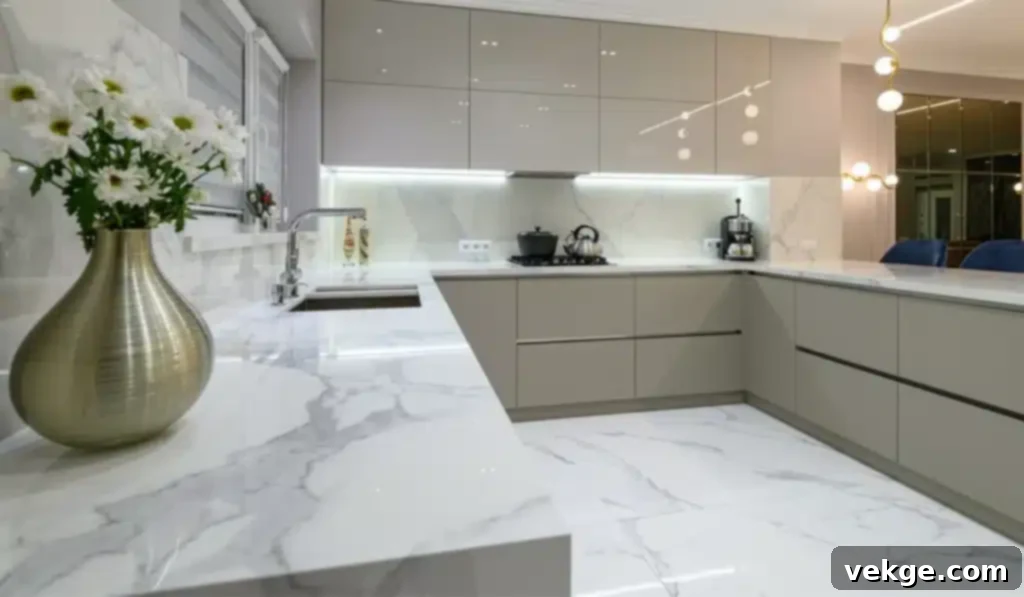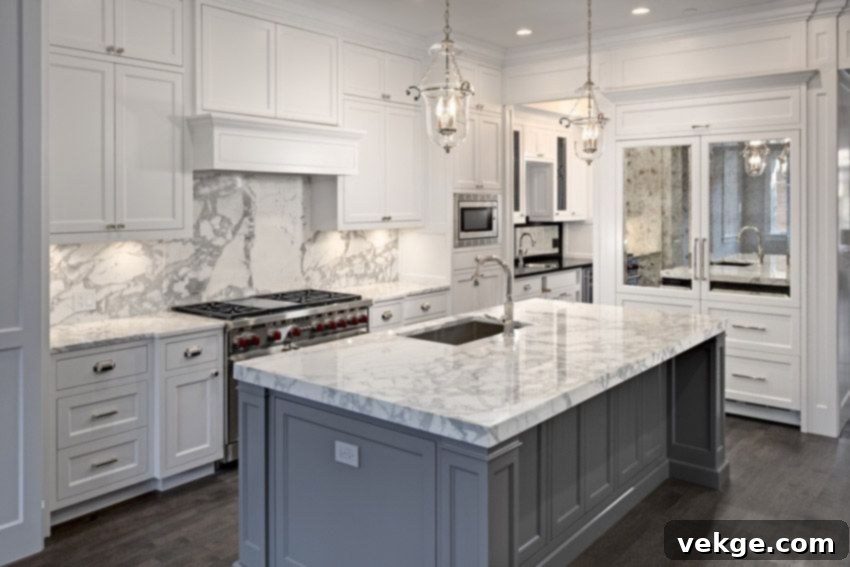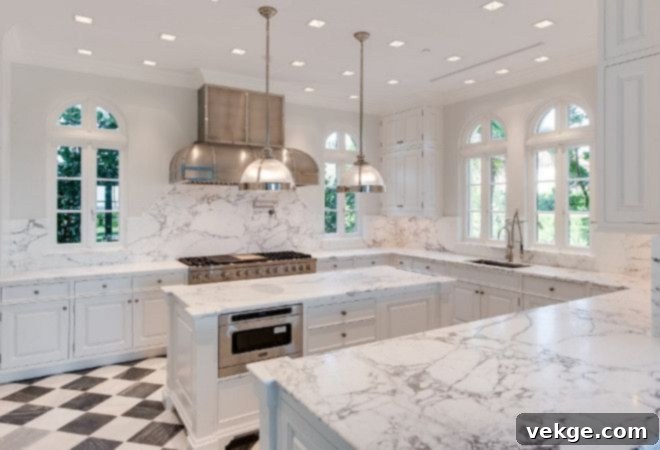White Marble Countertops for Kitchens: The Ultimate Guide to Pros, Cons & Design Tips
The kitchen, often considered the heart of the home, is a space where both functionality and aesthetics play crucial roles. Your choice of countertops speaks volumes about your personal style and sets the overall tone for this vital area. Among the myriad of options available, marble has consistently held its place as a top contender for homeowners seeking to infuse their kitchens with unparalleled elegance and character.
For centuries, this exquisite natural stone has been celebrated for its ability to transform spaces, offering a luxurious touch that is both timeless and captivating. When it comes to marble, particularly white marble, the visual impact is nothing short of mesmerizing. Its pristine backdrop interwoven with delicate, often dramatic, veining creates an artistic masterpiece that no two pieces can perfectly replicate. This unique charm makes white marble a highly sought-after material, yet its suitability for the demanding environment of a kitchen often sparks debate among design enthusiasts and practical homeowners alike. This comprehensive guide aims to delve into all the considerations surrounding white marble countertops, helping you determine if this classic choice is the perfect fit for your culinary sanctuary.
Deciding on White Marble for Your Kitchen: A Detailed Perspective
Marble, in all its various forms and colors, undeniably imparts a sense of grandeur to any space it graces. However, the appeal of white marble is particularly potent, offering a bright, clean, and expansive feel that can elevate kitchen aesthetics to new heights. As we explore the intricacies of incorporating white marble into your kitchen, it’s essential to consider all surrounding elements to ensure a harmonious and lasting design.
Opting for white marble in the kitchen promises a vibrant and refined look, capable of transforming a mundane cooking area into a luxurious focal point. Yet, making such a significant design choice requires a thorough understanding of both its undeniable advantages and its practical limitations. Homeowners often weigh white marble against other popular materials like quartz or granite, typically driven by two primary factors: an unparalleled aesthetic desire and the perceived long-term value. In the following sections, we’ll provide critical insights and tips to guide your decision-making process, offering a balanced view of the pros and cons to help you select the ideal countertop material for your dream kitchen.
Advantages of White Marble Countertops for Your Kitchen

1. Unrivaled Aesthetic Appeal and Timeless Elegance
The sheer presence of white marble instantly elevates the perceived value and luxury of any kitchen. This stunning natural material exudes a sophistication that can transform your kitchen’s entire character, offering a visual richness that is hard to match. Its bright, reflective surface can make a kitchen feel larger and more open, while its classic beauty seamlessly integrates with diverse design styles, from traditional farmhouse to sleek modern minimalist. The soft, elegant white background often features intricate grey, gold, or even subtle pink veining, creating a dynamic and captivating pattern that acts as a true centerpiece. Popular varieties like Carrara, Calacatta, and Statuario each offer distinct veining characteristics, allowing for personalized aesthetic statements that perfectly complement your home’s existing décor.
2. Enduring Value and Investment Potential
While granite once held the crown as the preferred luxury countertop material, its market value and popularity have seen fluctuations. Marble, however, particularly white marble, has consistently maintained its allure and appreciation over the years. Its timeless elegance ensures that a marble kitchen will never look dated, contributing to the long-term resale value of your home. Unlike trends that come and go, marble’s classic appeal ensures it remains a desirable feature, signaling quality and luxury to potential buyers. Choosing white marble is not just a design decision; it’s an investment in enduring style and perceived value that sets your property apart.
3. The Beauty of Uniqueness
One of the most compelling aspects of natural marble is its inherent uniqueness. While marble itself is a widely used stone, no two slabs are ever exactly alike. Each piece boasts its own distinctive veining patterns, color variations, and natural characteristics, making every white marble countertop installation a bespoke work of art. This individuality is a significant advantage for homeowners who aspire to create a kitchen that is truly one-of-a-kind, reflecting a personalized style statement. It ensures that your kitchen will have an exclusive touch, providing a sense of individuality and custom craftsmanship that synthetic materials simply cannot replicate.
Disadvantages of Adding White Marble Countertops to Your Kitchen

1. Significant Cost Investment
While undeniably elegant and desirable, white marble countertops typically come with a higher price tag compared to many other popular kitchen countertop materials. The cost encompasses not only the raw material itself but also the specialized fabrication, transportation, and installation required for such a delicate and heavy stone. This premium pricing can be a considerable factor for homeowners on a strict budget. While it’s tempting to seek cheaper alternatives, compromising on quality for such a visible and frequently used surface can ultimately detract from the overall aesthetic and functionality of your kitchen. Investing in quality marble often means a larger upfront expenditure, but for many, the unparalleled beauty and enduring appeal justify the cost.
2. The Imperative for Regular Sealing and Maintenance
Perhaps the most significant practical concern with white marble countertops is their porous nature and susceptibility to staining and etching. Like many natural stones, marble requires regular sealing to create a protective barrier against liquids that could otherwise seep in and cause permanent discoloration. Without diligent resealing, even common kitchen spills like red wine, coffee, olive oil, or acidic substances (lemon juice, vinegar) can leave noticeable marks. Depending on the quality of the stone and the frequency of use, you might need to reseal your marble countertops anywhere from once to four times a year. This ongoing maintenance not only adds to the overall cost but also demands a consistent time commitment, which can be a deterrent for busy homeowners.
3. Susceptibility to Wear, Etching, and Patina Development
It’s important to understand that marble, while durable, is a relatively softer stone compared to granite or quartz. This means it is more prone to scratching, chipping, and etching (a dulling of the surface caused by acidic substances reacting with the calcium carbonate in the marble). Over time, these minor imperfections can accumulate, leading to a “patina” – a softened, aged look that some find charming and character-rich, while others perceive it as damage. Maintaining a pristine, like-new appearance requires meticulous care and potentially professional restoration services. Addressing deep scratches or significant etching can be costly, and for those who prefer an unblemished surface, the natural aging process of marble might be a source of frustration. Understanding and embracing marble’s tendency to show its history is crucial before making a commitment.
The final decision to incorporate white marble into your kitchen ultimately hinges on a balance of personal preferences, budget constraints, and willingness to commit to its specific maintenance requirements. However, even if you’ve decided to embrace the timeless beauty of white marble, there are several essential factors to consider to ensure a successful and satisfying installation. Below, we’ve summarized four crucial points for effectively integrating this luxurious material into your cooking space.
Essential Tips to Consider When Selecting White Marble Countertops
1. Carefully Consider the Combination of Different Marble Slabs
It’s crucial to remember that every slab of natural stone is unique. To achieve a cohesive and aesthetically pleasing outcome, it is highly recommended to view and approve the exact pieces of marble you intend to use for your countertops. Avoid the disappointment of mismatched patterns or color variations by physically inspecting the slabs side-by-side. Consider how different pieces will be cut and joined to form a continuous flow, especially in larger kitchens or with waterfall island designs. The goal is to ensure that the individual characteristics of each slab come together seamlessly to create a pattern that is not only functional but also visually stunning and harmonious throughout your kitchen.
2. Take the Veining Pattern and Cut into Consideration
The distinctive veining of marble is its signature feature, and how the stone is cut significantly impacts its final appearance. Different quarries produce marbles with varying vein densities and patterns. Marble blocks can be cut in two primary ways:
- Cross-Cut (Fleuri Cut): This method cuts parallel to the natural bedding planes, revealing open, flowery patterns with more randomized veining. It offers a softer, more organic aesthetic.
- Vein-Cut: This method cuts against the bedding planes, resulting in a linear, striped pattern where veins run in a more uniform direction. This can create a dramatic, modern look.
Beyond the cut, consider “bookmatching” – a technique where two adjacent slabs are cut and polished to create a mirror image of each other, resulting in a striking symmetrical pattern that can be a breathtaking focal point, particularly on large islands or backsplashes.
3. Explore Different Finishes Through Transformation
The surface finish of your white marble can dramatically alter its look and performance in the kitchen. Beyond the traditional polished finish, several other options can provide a distinct aesthetic and feel:
- Polished Finish: This is the most common and classic choice, offering a high-gloss, reflective surface that enhances the stone’s colors and veining. It provides a luxurious shimmer but is more prone to showing etching and scratches due to its reflectivity.
- Honed Finish: A honed finish provides a matte or satin appearance, achieved by stopping the polishing process earlier. It offers a softer, less formal look and can be more forgiving in terms of showing minor etching, as the lack of shine makes imperfections less noticeable. However, honed surfaces can sometimes be more susceptible to staining if not properly sealed.
- Leathered/Brushed Finish: This modern finish offers a textured, slightly uneven surface reminiscent of leather. It provides a unique tactile experience and is excellent at hiding fingerprints, smudges, and minor imperfections. It’s often sealed and has a more rustic yet sophisticated appeal.
Each finish offers its own set of advantages and challenges, so consider which best aligns with your design vision and lifestyle.
4. Consider Giving Your Countertop Distinctive Edge Profiles
Beyond the slab itself, the edge profile of your white marble countertop is a subtle yet significant design element that can amplify its importance and refine the overall look of your kitchen. The right edge can enhance natural beauty, improve safety, and contribute to the kitchen’s style. Common edge profiles include:
- Eased Edge: A simple, slightly rounded edge that provides a clean, modern look and reduces sharpness.
- Half-Bullnose/Full-Bullnose: Rounded edges that offer a softer, more traditional appearance and are very comfortable for leaning against. Full-bullnose edges are fully rounded top and bottom.
- Ogee Edge: A classic, elegant profile featuring an S-shaped curve, often chosen for traditional or highly decorative kitchens.
- Bevel Edge: A slanted or angled cut on the top edge, offering a contemporary and architectural feel.
Custom milling machines allow for a wide array of intricate edge designs, enabling you to add a unique, custom-fabricated touch that perfectly complements your kitchen’s aesthetic. Selecting an appropriate edge profile ensures that every detail contributes to the cohesive elegance of your white marble kitchen.
Wrapping it Up: Is White Marble Right for Your Kitchen?
Choosing white marble for your kitchen countertops is a decision that undoubtedly makes a profound statement about luxury, elegance, and timeless style. It transforms a functional space into a showpiece, bringing a level of sophistication that few other materials can rival. However, the allure of its breathtaking beauty should be balanced with a clear understanding of the practical commitments involved in owning and maintaining this exquisite natural stone.
As this detailed guide has outlined, white marble comes with a unique set of advantages and disadvantages. While each slab enhances marvelous elegance and offers unparalleled uniqueness, factors such as the initial cost, the necessity of regular sealing, and the material’s susceptibility to etching and the development of a patina must be carefully prioritized. It’s crucial to conduct thorough research, weigh the pros and cons against your personal lifestyle, budget, and design aspirations, and consider how well you are prepared for its specific care requirements.
Ultimately, an informed decision ensures that your white marble countertops will not only look stunning but will also bring you lasting satisfaction for years to come. We hope this comprehensive guide has served its purpose in illuminating the path to your ideal kitchen. Your feedback is invaluable and will help us continue to provide insightful guidance for future home renovation and decor projects, helping others make equally well-informed decisions.
